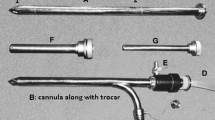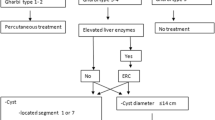Abstract
Hepatic hydatid cysts (HHC) are not uncommon in children, and a large number of cases are treated surgically every year in Kashmir. Capitonnage is commonly used to deal with the residual pericyst cavity after enucleation of the endocyst, but its recognized major complications are hydrops and secondary infection in the residual cavity. In this randomized study, a prospective and retrospective evaluation was done to compare capitonnage with the open method of treating HHCs. In 42 children, group I (n=23) treated by capitonnage and group II (n=19) treated by the `open' method, there was no mortality. Group II patients had a more rapid recovery and fewer postoperative complications as well as a shorter total hospital stay compared to group I patients.
Similar content being viewed by others
Author information
Authors and Affiliations
Additional information
Accepted: 5 October 2000
Rights and permissions
About this article
Cite this article
Khursheed, A., Abrar, A., Tariq, H. et al. Open method versus capitonnage in management of hepatic hydatidosis in children. Pediatr Surg Int 17, 382–385 (2001). https://doi.org/10.1007/s003830000572
Issue Date:
DOI: https://doi.org/10.1007/s003830000572




